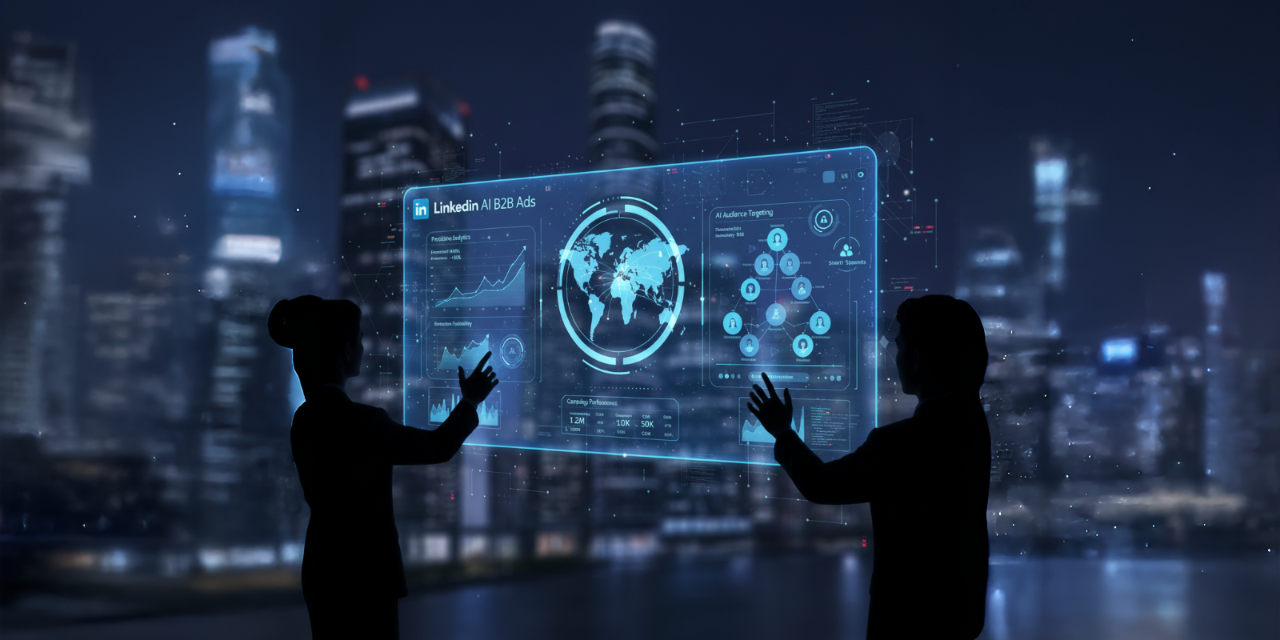LinkedIn AI B2B Ads are transforming how businesses connect, interact, and convert in 2025. As the largest professional network, LinkedIn now uses advanced artificial intelligence to deliver smarter audience targeting, predictive campaign optimization, and AI-enhanced creative suggestions.
With over 1 billion users and a 60% increase in ad engagement across Asia, this AI-powered shift marks a major milestone in automating B2B marketing. As a result, companies looking to improve lead quality, reduce cost per acquisition, and enhance personalization can now rely on LinkedIn’s intelligent marketing tools to make campaigns truly game-changing.
AI and Precision Targeting
Audience intelligence driven by AI stands as one of the most transformative updates in LinkedIn’s ad innovation. Through real-time behavioral analytics, industry insights, and predictive modeling, the platform identifies high-value prospects by analyzing job titles, company size, and intent signals.
For example, when defining an audience such as IT decision-makers in fintech startups, LinkedIn’s AI tool refines results based on engagement patterns, job history, and spending behavior. This ensures every ad impression counts.
Furthermore, AI adjusts targeting dynamically, learning from campaign results in real time. Consequently, marketers achieve higher CTR, lower CPC, and a better ROI, without spending hours on manual optimization.
Optimized Intelligent Creativity
Beyond targeting, LinkedIn’s AI system also transforms advertisement content. It analyzes audience metrics and automatically suggests changes to ad captions, image variations, and calls-to-action (CTAs).
Moreover, with the integration of natural language processing algorithms, the system reviews tone, keywords, and visual balance to match audience preferences. This enables marketers to maintain brand consistency while maximizing engagement.
This innovation is similar to Google’s Performance Max and Meta’s Advantage+ Ads, yet it is uniquely designed for B2B lead generation and relationship marketing — giving businesses a clear advantage..
Predictive Analytics for Intelligent Decision-making
The update also introduces AI-powered predictive analytics. It allows marketers to estimate campaign success metrics before launching, based on billions of data points. The AI predicts reach, engagement, and conversion potential, helping businesses make data-driven decisions.
With a marketing data roadmap, teams can allocate resources efficiently, avoiding wasted budget on underperforming audiences. LinkedIn’s internal studies show that B2B brands using predictive intelligence can shorten conversion cycles and increase the number of qualified leads significantly.
Integration with Marketing Automation Tools
Another major advantage is seamless integration with automation tools like HubSpot, Salesforce, and Zapier. As a result, marketers can automate nurture sequences and sync real-time engagement data directly into CRM systems.
For digital agencies and SaaS marketers, this means less manual effort and more intelligent automation — from the ad click to final conversion. Furthermore, unified CRM and ad systems enhance personalization, ensuring every lead receives timely and relevant messages.
Impact on the B2B Marketing Landscape
LinkedIn’s AI expansion represents a fundamental transformation in how marketers approach B2B advertising. Real-time learning models now replace static targeting and conventional ad creatives.
Additionally, this evolution aligns with the broader convergence of AI, automation, and intent-based advertising. In an age where attention spans are short, delivering the right message to the right audience at the right time has become a decisive competitive edge.
Challenges and Considerations for LinkedIn AI B2B Ads
Despite the benefits, marketers must also address new challenges:
- Data Ethics: Ensuring responsible AI use and compliance with evolving privacy laws.
- Learning Curve: Understanding AI behavior and algorithm logic to fully leverage automation.
- Measurement Complexity: Managing advanced analytics for attribution and reporting accuracy.
Nevertheless, these challenges can be overcome by combining ethical frameworks, training, and strategic oversight. When done right, AI becomes an ally, not an obstacle.
Conclusion
2025 is the year LinkedIn AI B2B Ads will make marketers’ jobs easier. With AI automation throughout campaign creation, including targeting, analytics, and creativity, firms will experience higher efficiency, precision, and ROI.
Ultimately, this shift marks a revolution, not just an upgrade, in digital advertising. Companies that adopt early will lead the future of automated B2B marketing, shaping how businesses connect revenue with relationships in the digital era.



Great FAQ section — answered the exact questions I had.
There is definately a lot to find out about this subject. I like all the points you made